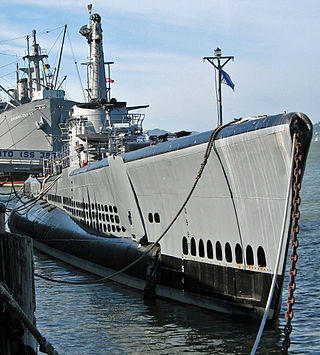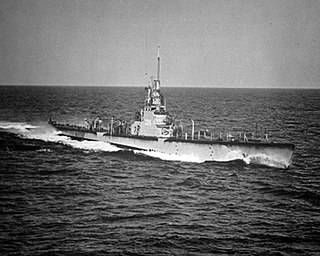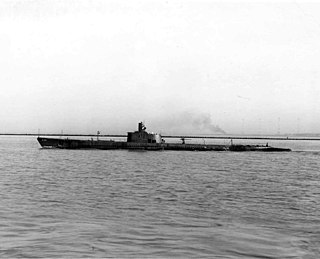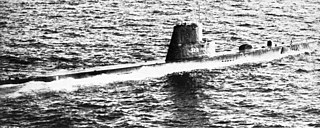
USS Pampanito (SS-383/AGSS-383), a Balao-class submarine, is a United States Navy ship, the third named for the pompano fish. She completed six war patrols from 1944 to 1945 and served as a United States Naval Reserve training ship from 1960 to 1971. She is now a National Historic Landmark, preserved as a memorial and museum ship in the San Francisco Maritime National Park Association located at Fisherman's Wharf in San Francisco, California.

USS Cod (SS/AGSS/IXSS-224) is a Gato-class submarine, the only vessel of the United States Navy to be named for the cod, an important and very popular food fish of the North Atlantic and North Pacific oceans. She was launched on 21 March 1943, and commissioned on 21 June 1943.

USS Silversides (SS/AGSS-236) is a Gato-class submarine, the first ship of the United States Navy to be named for the silversides.

USS Drum (SS-228) is a Gato-class submarine of the United States Navy, the first Navy ship named after the drum, a type of fish. Drum is a museum ship in Mobile, Alabama, at Battleship Memorial Park.

USS Bashaw (SS/SSK/AGSS-241), a Gato-class submarine, was the first ship of the United States Navy to be named for the bashaw. Between 10 March 1944 and 29 April 1945, she completed six war patrols in the Celebes, Philippine, and South China Seas during World War II. Bashaw sank three Japanese merchant vessels totaling 19,269 gross register tons as well as several small craft. She later served in the Vietnam War.

USS Croaker (SS/SSK/AGSS/IXSS-246), a Gato-class submarine, was the first ship of the United States Navy to be named for the croaker, any of various fishes which make throbbing or drumming noises.

USS Mingo (SS-261) — a Gato-class submarine — was the first ship of the United States Navy to be named for the mingo snapper.

USS Puffer (SS-268), a Gato-class submarine, was the first ship of the United States Navy to be named for the puffer.

USS Raton (SS/SSR/AGSS-270), a Gato-class submarine, was a ship of the United States Navy named for the raton, a polynemoid fish inhabiting semitropical waters off the Pacific coast of the Americas.

USS Redfin (SS/SSR/AGSS-272), a Gato-class submarine, was a ship of the United States Navy named for the redfin, any of several North American fishes with reddish fins.

USS Rock (SS/SSR/AGSS-274), a Gato-class submarine, was a ship of the United States Navy to be named for the rockfish, a striped bass found in the Chesapeake Bay region and elsewhere along the United States East Coast.

USS Becuna (SS/AGSS-319), a Balao-class submarine in commission from 1944 to 1969, was a submarine of the United States Navy named for the becuna, a pike-like fish of Europe. During World War II, she conducted five war patrols between August 23, 1944 and July 27, 1945, operating in the Philippine Islands, South China Sea, and Java Sea. She is credited with sinking two Japanese tankers totaling 3,888 gross register tons.

USS Caiman (SS-323), a Balao-class submarine, was a ship of the United States Navy that was later transferred to the Turkish Naval Forces in 1972 under the Security Assistance Program, where she was recommissioned as the third TCG Dumlupınar. She was retired in 1986.

USS Charr (SS/AGSS-328), a Balao-class submarine, was a ship of the United States Navy named for the charr.

USS Capitaine (SS/AGSS-336), a Balao-class submarine, was a ship of the United States Navy named for the capitaine, a brilliantly colored fish inhabiting waters of the Atlantic Ocean from North Carolina to Panama.

USS Guavina (SS/SSO/AGSS/AOSS-362), a Gato-class submarine, was a ship of the United States Navy named for the guavina, a fish which may reach a length of 2 feet (0.6 m) indigenous to the West Indies and the Atlantic coasts of Central America and Mexico.

USS Hardhead (SS-365), a Balao-class submarine, was a ship of the United States Navy named for the hardhead, a fish of the croaker family.

USS Icefish (SS-367), a Balao-class submarine, was a ship of the United States Navy named for the icefish, any member of the family Salangidae, small smeltlike fishes of China and Japan. These fish are also collectively known as whitebait.

USS Lamprey (SS-372), a Balao-class submarine, was a ship of the United States Navy named for the lamprey, any of certain eel-like aquatic vertebrates.

USS Loggerhead (SS-374/AGSS-374), a Balao-class submarine, was a ship of the United States Navy named for the loggerhead, Caretta caretta, a very large, carnivorous sea turtle common in the warmer parts of the Atlantic, Pacific, and Indian Oceans.

























